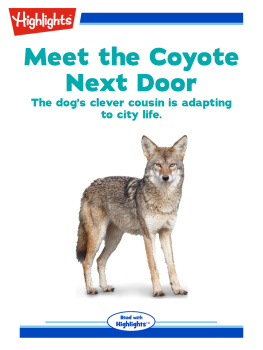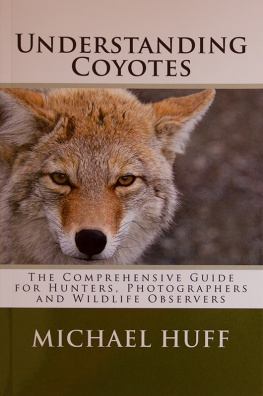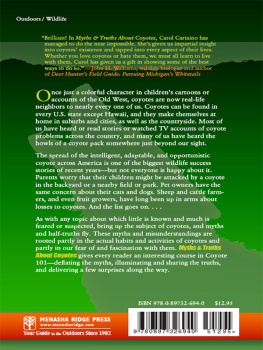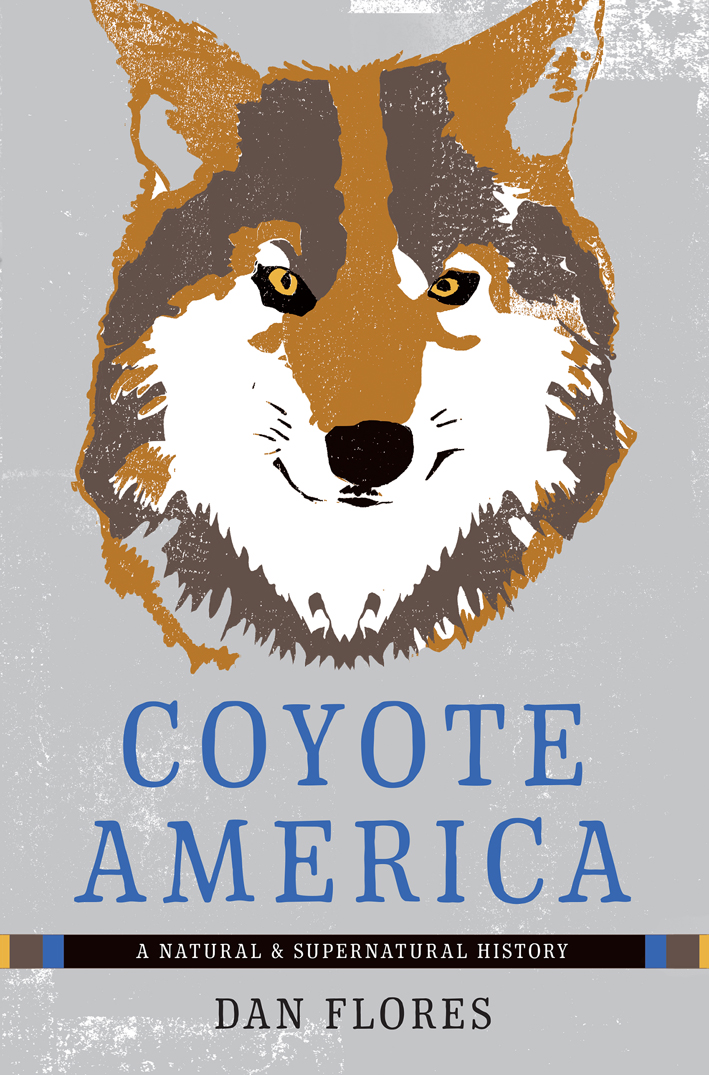More Advance Praise for
COYOTE AMERICA

In this brilliant book, Flores traces the wane and wax of the coyote. Their story is interwoven with our story, but it is also like our story, that of a species that has faced challenges and overcome them. Read this book if you want to understand the wild canids among us and also, perhaps, a little bit more about yourself.
Rob Dunn, author of The Man Who Touched His Own Heart
A wily writer meets his natural subject. With erudition, pathos, and seductive humor, Flores tells coyote stories that expose the animalism of Americans, and humans everywhere. The pleasure of his book is the feeling of being alive.
Jared Farmer, author of Trees in Paradise

ALSO BY DAN FLORES

American Serengeti: The Last Big Animals of the Great Plains
Visions of the Big Sky: Painting and Photographing the Northern Rocky Mountain West
The Natural West: Environmental History in the Great Plains and Rocky Mountains
Horizontal Yellow: Nature and History in the Near Southwest
Caprock Canyonlands: Journeys into the Heart of the Southern Plains
Canyon Visions: Photographs and Pastels of the Texas Plains
Journal of an Indian Trader: Anthony Glass and the Texas Trading Frontier
Southern Counterpart to Lewis and Clark: The Freeman and Custis Expedition of 1806
The Mississippi Kite: Portrait of a Southern Hawk

Copyright 2016 by Dan Flores
Published by Basic Books,
A Member of the Perseus Books Group
All rights reserved. Printed in the United States of America. No part of this book may be reproduced in any manner whatsoever without written permission except in the case of brief quotations embodied in critical articles and reviews. For information, contact Basic Books, 250 West 57th Street, New York, NY 10107.
Books published by Basic Books are available at special discounts for bulk purchases in the United States by corporations, institutions, and other organizations. For more information, please contact the Special Markets Department at the Perseus Books Group, 2300 Chestnut Street, Suite 200, Philadelphia, PA 19103, or call (800) 810-4145, ext. 5000, or e-mail .
Designed by Trish Wilkinson
Set in 11.5-point Adobe Caslon Pro
Library of Congress Cataloging-in-Publication Data
Names: Flores, Dan L. (Dan Louie), 1948, author.
Title: Coyote America: a natural and supernatural history / Dan Flores.
Description: New York: Basic Books, 2016. | Includes index.
Identifiers: LCCN 2015043370 (print) | LCCN 2016001156 (ebook) | ISBN 9780465098538 (e-book)
Subjects: LCSH: CoyoteNorth AmericaHistory.
Classification: LCC QL737.C22 F63 2016 (print) | LCC QL737.C22 (ebook) | DDC 599.77/25dc23
LC record available at http://lccn.loc.gov/2015043370
10 9 8 7 6 5 4 3 2 1
For Sara
Table of Contents
Guide
Contents

Few creatures on Earth possess a biography to match the coyotes.
Courtesy Dan Flores.

H ere is a vivid memory. I am on winter break from my university duties, and I am home visiting my parents in Louisiana. We are up early, stirring around in the kitchen in a gray, misty dawn in our hometown near the Black Bayou in the north of the state. My dad knows the paper will already be in the mailbox and asks me to walk out to the end of the driveway to fetch it in. I am in the act of pulling the Shreveport Times out of the box in silvery-blue twilight when I hear a rhythmic clatter and the scratching of toenails on the asphalt street. Plastic-wrapped newspaper in hand, I turn toward the commotion and find myself staring into the face of a coyote, which shoots me a quick sidelong glance as it passes by mere feet away, rocking along in that characteristic lope with which coyotes go through the world, close enough to pepper my ankles with dislodged gravel as it digs in to swerve past me. I register hot yellow eyes and something in its mouth. Maybe its the neighbors cat, although in the dim light it looks more like a trio of tallboys dangling from plastic six-pack rings.
Open-mouthed, I follow its course down the street, when a second coyote appears, weaving through three cars parked on the road opposite my parents home. Pink tongue lolling, this one fixes me with a look that has something of a been-good-to-know-you wave as it passes, and in another couple of seconds it is at the corner intersection at the end of the block. There it pauses for an instant, turns to look back at me, then is gone in a movement I barely discern, like smoke dispersed by a sudden swirl of wind. Coyote number two seems empty-handed, and I register the thought (and tell my dad back in the kitchen), Ah, those looked like pull-tab beers anyway, so no bottle opener needed.
I tell this story not because it is unusual but for exactly the opposite reason. In twenty-first-century America likely a hundred scenes something like this unfold in towns and cities from coast to coast every morning. Close encounters with coyotes have now become the countrys most common large-wildlife experience. They happen everywhere, in small towns like the one where I was raised and in gigantic cities: Los Angeles, San Francisco, Denver, Atlanta, Chicago, and now even New York City, the coyotes final frontier. A study of print media from 1998 to 2010 found a whopping 1,214 newspaper and magazine articles dedicated to human-coyote encounters in the United States for those years, and of course those included only the newsworthy events. Many thousands more like mine in Louisiana occurred without anyone calling a reporter. According to Stan Gehrt, Chicagos urban coyote guru ecologist, every major city in America now has a coyote-management study underway.
Our senseand this is the way most media and online stories about coyotes have presented the matteris that this is a brand-new phenomenon and something for which we humans are wholly responsible. Those sentiments reflect urban legend and human hubris. Urban coyotes are in no sense new in American history. And in truth, we are far less responsible than they are for their arrival everywhere among us now. In one of the myriad ways humans and coyotes eerily mimic one another, like us coyotes are a cosmopolitan species, able to live in a remarkable range of habitats. In our case, we have cleverly enhanced our own cosmopolitanism by taking our evolutionary habitat with us around the world: every North American home from Fairbanks to Tucson is heated or cooled to seventy-two degrees, the ambient temperature of the African setting where we evolved. Coyotes havent bothered with recreating their desert and plains habitats wherever theyve gone, but they have sought out prairies, habitat edges, and natural areas as they have colonized the continent, and they have assuredly used cleverness in spreading from their original home in the West across North America.

















